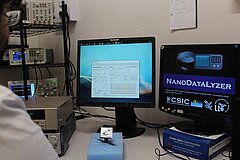The Spanish National Research Council (CSIC), through the Institute of Materials Sciences of Seville (ICMS), has developed a new computer program called ‘NanoDataLyzer’ that allows the scientific community, focused especially on the research of nanogenerators or ‘nanochargers’, to speed up the calculations and analysis of the functionality of these devices. These devices are currently used in technological applications related to the Internet of Things (IoT), as well as the renewable energy industry, medicine or smart agriculture.
Thus, the Nanotechnology in Surfaces and Plasma research team has included in this software functionalities that allow the automation of power and energy measurements and statistical analysis of the results. In addition, this computer application not only allows tests with nanogenerators to convert kinetic energy (movement), it is also applicable to other systems such as pyroelectric and thermoelectric nanogenerators for energy use of temperature variations and gradients, and even to systems that capture vibrations, temperature and light at the same time. Another important feature of the software is that, in addition to improving and optimizing the treatment of the signals emitted by the nanogenerator, it includes great versatility. Thanks to the “Create dataset batch” section, new source codes can be included that will be included in NanoDatalyzer. This functionality allows users to perform new calculations and measurements of their devices and automate tests to check their functionality.
How NanoDataLyzer Works
Until now, researchers used up to two simultaneous programs to analyze the behavior of a nanogenerator. Scientists introduced a stimulus to the nanogenerator (temperature, friction, humidity, force, etc.) and measured the behavior of the device with various programs from Origin, Excel or other calculation programs.
NanoDataLyzer simply requires the loading of a file (.csv, xlx, etc.) to automate the calculations. The processing models are voltage-time or intensity-time with or without resistance and can perform the calculations with the desired unit of measurement. In addition, it allows the inclusion of mathematical operations that will be applied to the measurements made (stimulus data). On the other hand, NanoDataLyzer allows the automatic generation of graphs using a button (stimulus plot) to study the response of the device in different variables with the basic tools (movement, enlargement or modification).
In addition, the program includes several algorithms to apply such as Fast Fourier Transform, Adjanted averaging (moving average), Savirzky-Golay, Lowess and Loess, joining the parameters chosen by the user. Another block of this program is the Integration section that allows you to easily calculate the energy in joules or watts. Finally, it also allows you to perform average statistics of the signals entered through the “Apply average” tool.
NanoDataLyzer has been designed using the MatLab technical calculation language for Windows and can be easily downloaded and installed through the Zenodo platform and GitHub, since it only requires mentioning the attribution of the program in the published measurements. “It is a software that makes nanogenerator measurements much easier. Fully characterizing these devices means doing many repetitive tests and calculations that now with NanoDataLyzer we can automate with a couple of clicks. “It saves researchers a lot of time,” says predoctoral researcher Xabier García Casas (CSIC), who developed this program together with researchers Gloria Moreno, Fernando Núñez, Triana Czermak, Hari Krishna, Francisco J. Aparicio, Juan R. Sanchez, Ángel Barranco and Ana Borras.



